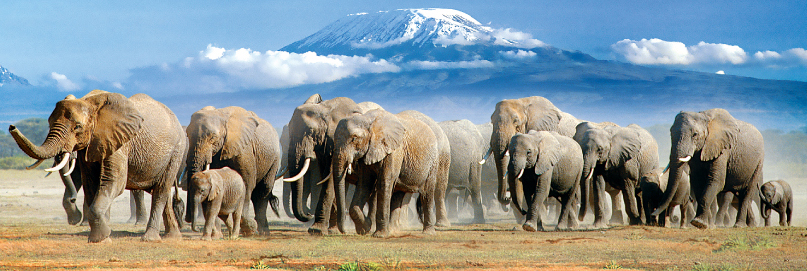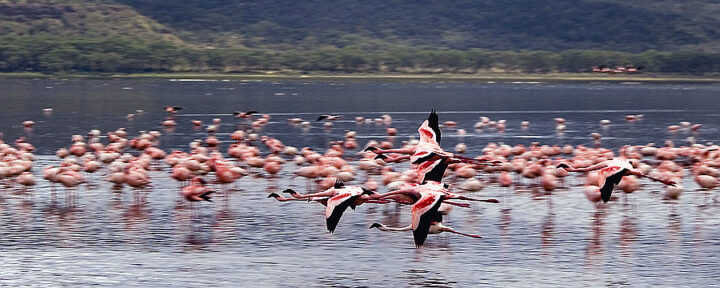Kenya Lakes
Kenya is one of the richest African countries in terms of nature and biodiversity with its infinite savannahs, its equatorial forests, its extinct volcanoes, its fresh and saltwater lakes, its deserts, its glaciers and its caves.
Kenya’s lakes are one of the most beautiful and largest in the world.
Each of the different lakes of Kenya has particular characteristics: some are a paradise for birdwatchers, others host extraordinary landscapes of hot springs and geysers, others have marvelous islands, some are shared by Kenya with neighboring countries, and some have a source really interesting. What unites them is a truly superb beauty.
Kenya is characterized by very different landscapes and undoubtedly what can be seen in the Rift Valley, the deep scar that winds the eastern edge of Africa, also meets the most demanding travelers, as it offers a landscape consisting of a tectonic pit Very extensive that was created 35 million years ago.
The Rift Valley of the Kenyan section extends north of Nairobi, and is an interesting itinerary that winds through the most beautiful scenery in Africa. The rift in the earth’s crust is dotted with lakes, volcanoes, rivers and mountains that continue on a path of more than 500 km.
In this area it extends important African lakes such as Lake Turkana, Lake Naivasha, Lake Magadi, Lake Elmenteita, Lake Baringo, Lake Bogoria and Lake Nakuru, in addition to Lake Vittoria which is not directly part of the Rift Valley system, although it is actually located between the eastern and western branches of the same.
For those who decide to take a tour in this area it is clear that the beautiful itinerary will be dotted with numerous lakes, volcanoes and river with a distance of 500 km. It is recommended to go this route during the driest seasons so that the path is pleasant.
To enjoy a pleasant hike the most suitable thing is to stay in the so-called “lodges” or in the tended watch camps so you can enjoy some comfort, but under the strict control of the ranger, who even overnight surround the perimeters inhabited.
The Rift Valley Kenyan is a lovely area, and during your holidays in Kenya it is really recommended to enjoy the “African” landscapes.
Lake Victoria: located on a plateau between the eastern and western branches of the Rift Valley, is one of the largest lakes across the African continent. It takes the name of Queen Victoria and its surface measures 68,870 sq. Km, which is why the largest tropical lake in the world has been elected. The main entourage of the lake is the Kagera River, which flows along the west shore. A single emissary is present and it is the White Nile that begins the waterway in Uganda, northwest of Lake Victoria. Inside, there are over 3,000 islands, many of them are not inhabited, but some have become a tourist destination.
Lake Nakuru: its name is of Masai origin and means “dust” or “dusty place”. The lake is located within the National Park of Nakuru Lake, in the south of the region, at an altitude of 1754 m above sea level. It is also part of the Rift Valley and its large quantity of algae recalls pink flamingos that give a unique spectacle, especially to tourists, on the agenda. But there are also baboons and warthogs, or black and white rhinos.
Lake Naivasha: located in the northwest part of the city of Nairobi, is a freshwater lake and its name derives from the word “Nai’posha ” which means “agitated waters” because of a sudden torment that you They hit the area. Its surface measures 139 sq. Km and is surrounded by a swamp of 65 sq. Km. The lake is enhanced by the Malewa and Gilgil rivers, as well as by some of the passage. There are no visible outlets, so it is assumed that there is a sliding underneath.
Lake Turkana: located in the northwest of Kenya, measures 6.405 sq. Km and is also called Lake Rodolfo, in honor of the astro-hungarian prince. The name was given to him by the pioneers who were the first Europeans to come to the shores in 1888. It was by Samuel Teleki and Ludwig von Honel. In 1975 he was given the Turkana name, taken by the ethnic group living there.
Lake Baringo: it is populated by inhabitants called Njemps. They are the only pastoral people who fish on board made of papyrus canoes, among crocodiles and hippos.
Lake Bogoria: lungo le sue coste abitano 60.000 pastori chiamati Endorois (Pokot), which have now begun to rebel against the government, due to the loss of their pastures and the total exclusion of their society from ruby sales revenues and other precious products achieved through their territory. Also, on its shores, Lake Bogoria hosts gorgeous animals such as flamingos, herons, pelicans and other species of birds and wildlife.
Lake Elmentaita: dry and dusty area, especially in the period January to March, the lake is located between Lake Naivasha and Nakuru Lake and the road to the side, makes it a great show for tourists traveling in their cars. In the south, hot springs can be found called “Kekopey” where you can swim without restriction, even legend says that so, you can cure AIDS. The lake hosts herons and pelicans, especially in its fishing areas.
Lake Magadi: located in the Rift Valley and the land of the Masai, south of Kenya, is inhabited mainly by pink flamingos. Its peculiarity is the fact that the surrounding volcanic hills that release sodium bicarbonate make it appear coated with crystallized soda.
Lake Jipe: is located on the border between Kenya and Tanzania, it is not part of the Rift Valley system. The northern shore of the lake is protected by the Tsavo West National Park, while the Tanzania side is close to the Game Reserve Mkomazi. The lake is known for its endemic fish species, as well as aquatic birds, mammals, wetland plants and marshes on the lake extending up to 2km from its banks.
There is a strong contrast between the southwest coast of the lake, where the Pare mountains to the north, with the Ugweno peaks, reach 1,800 and 2,000 meters above sea level, and the eastern side of the lake, completely flat in its territory To Kenya, with the red earth typical of the Kenyan plain.
From the lake you can see the Kibo peak of Mount Kilimanjaro.
Lake Logipi: is an alkaline lake situated at the northern end of arid Suguta Valley in the Rift Valley in northern Kenya. It is separated from Lake Turkana by volcanic Barrier, a group of young volcanoes that recently erupted during the late nineteenth century or early twentieth century.
During the rainy season, the lake is also recharged by Suguta river that flows north along the valley of Suguta, periodically forming a temporary lake (Lake Alablab) who joins the Logipi.
Logipi Lake has a maximum depth of 3 to 5 m, and measures about 6 km wide for 3 km in length. Its waters are a composition of sodium bicarbonate with a pH of 9,5-10,5 and salinity (total dissolved salts) which vary from less than 20 g / l to more than 50 g / l. Crusts of salt efflorescence (Trona, the name is a kind of anagram of natron for the richness in sodium of this mineral) are present around its margins. The flamingos often inhabit these waters feeding on the salt pans of cyanobacteria (Arthrospira spp. – previously called Spirulina) and other plankton.
Although not belonging to Kenya, they are directly part of the Rift Valley system Lake Tanganyika, Lake Natron and Lake Malawi.
Lake Tanganyika is the largest in East Africa although Tanzania and the Republic of Congo boast the territoriality of the lake. Deep 1470 feet and extended for more than 600 km is located within one of the great rivers of the Rift Valley, whose mountainous walls form the boundaries.
Discovered in 1858 during an expedition to discover the Nile, the lake hosts about 300 species of fish, resulting in a remarkable economic resource; The species that inhabit the lake are sardines, molluscs and fish that are similar to our Persian.
Lake Natron is a salt lake located at the Kenyan border with Tanzania, in the African Rift Valley at about 600 meters above sea level; Near its south-eastern shore is the Gelai Volcano. The lake, which barely reaches three meters deep, varies in width depending on the level of filling of its invasion.
The lake is famous for hosting bacteria that release a color that in its own way pigmentates its shiny water. In addition to these bacteria, the only living being that can survive in its waters is the flamingo, thanks to a protective stratum corneum on the feet and beak: in fact the water of this lake is not only soaked but extremely caustic even for the skin.
Lake Malawi or Lake Niassa is the third largest lake in Africa and the ninth largest in the world. It is the most south of the Great Rift Valley lakes. Along 560 km and with a maximum width of 75 km, most of the border between Malawi and Mozambique, and partly to Tanzania. Thanks to a maximum depth of 700 m it is considered one of the deepest lakes in the world. There are numerous canals and rivers flowing there; Among the streams fed the main is the Shire, affluent of Zambezi. In 1980, the southern part of the lake, around Monkey Bay, became a natural park (Malawi Lake National Park), declared UNESCO World Heritage Site in 1984.
In the colonial era, the lake was nicknamed “lake-calendar” due to the singular fact that its mileage (365) coincides with the number of days of the Gregorian calendar year and its mileage (52) Weeks of the year.
Malawi hosts at least 500 species of endemic cigars; They are extremely colorful and very appreciated fish for aquariums. Edible fish, the most renowned being the “chambo”, are an important resource for the local population (largely engaged in fishing).
Among the other animal species present in the lake can be mentioned the crocodiles and a large population of eagles.
The waters of the lake are infested by larvae of the parasitic worm causing the onset of schistosomiasis. Every year around 5,000 tourists contract this disease after coming into contact with the waters of this lake.
Kenya Lakes: (When necessary use translators)
Lake Victoria Lake Turkana Lake Nakuru Lake Bogoria Lake Baringo Lake Naivasha Lake Jipe Lake Elmentaita Lake Magadi Lake Logipi Lake Chala Lake Kamnarok Lake Chew Bahir Lake Kenyatta Lake Solai

